
E-mail: font@focusonnature.com
Phone: Toll-free in USA 1-888-721-3555
or 302/529-1876
 |
PO
Box 9021, Wilmington, DE 19809, USA E-mail: font@focusonnature.com Phone: Toll-free in USA 1-888-721-3555 or 302/529-1876 |
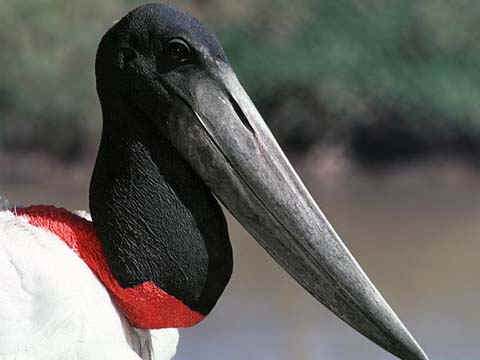
The Jabiru has been seen
during recent FONT tours
in Belize, Brazil, & Costa Rica
Links:
FONT E-News, July 27, 2012: Bird Taxonomy Updates, including 2 Murrelets where there was 1
FONT E-News, June 6, 2012: Snowy Plover, Kirtland's Warbler & Wolves in Wisconsin
FONT E-News, Mar 31, 2012: Our Recent Tours in Costa Rica & the Dominican Republic
FONT E-News, Jan 7, 2012: Our Recent Tour in Chile, with Parakeets, Penguins, & the Pudu
FONT E-NEWS, Oct 4, 2011: A Quiz with 2 Questions, and 2 Big Eagles
FONT E-NEWS, Sep 19, 2011: Tours, including one in Brazil where Roosevelt was in 1914
FONT E-NEWS, Aug 10, 2011: Jaguar & Jabirus in Brazil
FONT E-NEWS, Aug 5, 2011: Presentations about Birds & Other Nature to Groups & Organizations
FONT E-NEWS, Jul 27, 2011: Again a Gallinule as it should be & more
FONT E-NEWS, Jul 22, 2011: Lists & a Quiz, Tours, & Frogs
Earlier FONT E-NEWS Bulletins in 2011
The above link to E-News
relating to: Iceland, Puffins, Brazil, the very rare Forbes's Blackbird, the
very rare Northern Muriqui, Belize, Japan, Chile, and a newly-found
Storm-Petrel.
A Chronological List of Upcoming FONT
Birding & Nature Tours
FONT Past Tour
Highlights Narratives & Photo Galleries relating to Past FONT Tours
![]()
FONT E-News, Volume 22, Number 7
October 30, 2012
Upcoming FONT tours in places as diverse as Estonia & Ecuador,
and our upcoming winter-time tours in the Caribbean,
and the tropics of Central & South America
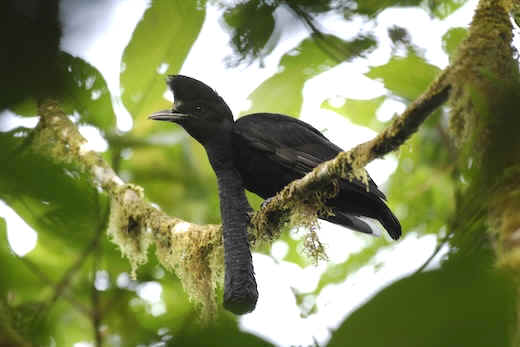
Above: an
Umbrellabird in Ecuador,
Below: butterflies in Brazil

BRAZIL:

A White-tailed Tropicbird
photographed during a FONT tour in early 2012
in the Dominican Republic
![]()
FONT E-News, Volume 22, Number 5
July 27, 2012
One Murrelet becomes Two, and what became of Caprimulgus?
Now here's a name to try to say quickly: "Scripps's Murrelet".
Yes it is the correct spelling , and it's now the name of what was part of the
Xantu's Murrelet. Now Mr. Xantu only has a hummingbird for a namesake.
The Scripps's Murrelet, Synthliboramphus
scrippsi, occurs at sea in California. It ranges outside the breeding season north, rarely, to northern California, and more rarely to Oregon and Washington State.
It breeds on islands off southern California: San Miguel, Santa Cruz, Anacapa, Santa Barbara, San Clemente, and formerly Santa Catalina, and in western Baja California, Mexico on San Benito, and Coronado and San Jeronimo islands. On larger islands (such as San Miguel, Santa Cruz, and San Clemente), it is confined largely or entirely to offshore rocks.
The other half of what was the Xantu's Murrelet is now the Guadalupe Murrelet,
Synthliboramphus hypoleucus. It breeds on offshore rocks and islands off western Baja California, Mexico from Guadelupe Island south to the San Benito islands.
Breeding is unconfirmed on San Martin Island, in Baja California, and San Clemente and Santa
Barbara Islands in California, USA.
It presumably winters offshore within the breeding range along the Pacific coast of Baja California.
Other changes in the 53rd Supplement of the American Ornithologists' Union
Check-List of North American Birds, July 2012, include the following:
If you've been in Costa Rica and you've seen what has been the Gray Hawk in BOTH the northern and the southern parts of the country, you can add a species to your list.
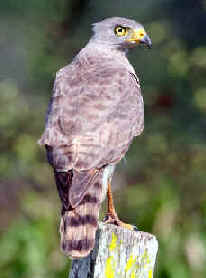
Gray Hawk
From northern Costa Rica north to Arizona and Texas, and rarely New Mexico, it is still the
Gray Hawk, with the scientific name of Buteo
plagiatus.
From southern Costa Rica south into South America, it is now the Gray-lined
Hawk, Buteo nididus.
South of Costa Rica, it is in Panama, Colombia, Venezuela, Trinidad & Tobago, the Giuanas. It is further south, west of the Andes to western Ecuador and east of the Andes to Paraguay, northern Argentina, and southern Brazil.
If you've been in Costa Rica, you may have another adjustment to your bird-list. it is now the
Costa Rican Brush Finch, Arremon costaricensis, in southwestern Costa Rica and adjacent western Panama, and the
Black-headed Brush Finch, Arremon atricapillus, further east in Panama. Both of these were part of the
Stripe-headed Brush Finch of further south, in South America, Arremon
torquatus.
If you've been to the Galapagos Islands, the Galapagos Shearwater, now Puffinus
subalaris, has been split from the Audubon's
Shearwater. Genetics have shown it to be more closely related to the Christmas Island
Shearwater.
Other changes in 2012 relate to genera:
The genus of the Calliope Hummingbird is now Selasphorus, the same genus as the
Rufous, Allen's, and Broad-tailed Hummingbirds.
The Calliope was in a genus of its own, Stelluta.
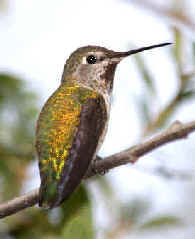
Caliope Hummingbird
Three North American finches are now in a new genus. The Purple, Cassin's, and
House Finch are now Haemorhous.
Previously they were in Carpodacus, an Old World genus containing the
Common, or Scarlet, Rosefinch and other similar species.

House Finch
Some of us learned Caprimulgus as the genus for the crepuscular and nocturnal birds known as
"goatsuckers". That Latin word, Caprimulgus, means "goat-milker".
Aristotle, among others, a long time ago, accepted the belief of shepherds that the birds would fly to the udders of goats for their milk, and thus the name.
Of course, in reality, those birds, both in the Old World and the New World, feed on flying insects.
Not due to nomenclature, but for anatomical reasons, Caprimulgus is GONE in the New World. The new genus of most of those birds is now
Antrostomus, and for some others, Hydropsalis.
Those in Antrostomus include: the Chick-will's-widow, the
Eastern Whip-poor-will, the Mexican Whip-poor-will, and the Buff-collared
Nightjar.
Others in Mexico and Central and/or South America are: Rufous Nightjar,
Tawny-collared Nightjar, Yucatan Nightjar, and the Dusky Nightjar.
Those on Caribbean islands are the Greater Antillean Nightjar, and the very rare & localized
Puerto Rican Nightjar.
Birds formerly in Caprimulgus that are now in the new genus
Hydropsalis include: the White-tailed Nightjar and the
Spot-tailed Nightjar.
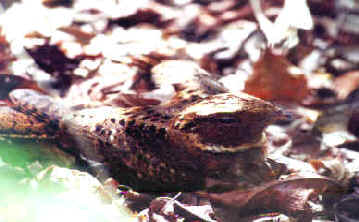
Rufous Nightjar
15 species of wrens, of Central & South America, and Mexico, are now in new genera:
Now in Pheugopedius, these Wrens: Black-throated, Black-bellied, Rufous-breasted,
Spot-breasted, Sooty-headed, and Happy (guessing it's "happy" now to be there).
Now in Thryophilus, these Wrens: Sinaloa (that's the rarity that was found a couple years ago in southern Arizona),
Rufous-and-white, and Banded.
Now in Cantorchilus, these Wrens: Stripe-throated, Stripe-breasted, Plain, Bay,
Riverside, and Buff-breasted.
All of these wrens were in the now-defunct genus Thryothorus.
Some raptors in Central and South America are now in different, or new, genera:
The Montane Solitary Eagle has been merged into
Buteogallus, the genus of the Black Hawks (the Common and the
Great) and others.
For the Plumbeous Hawk, of Panama for example, one now has to type more letters as
Leucopternis plumbeus has become Cryptoleucopteryx
plumbeus.
Also exiting Leucopternis have been the White
Hawk, now Pseudastur albicollis, and the Barred
Hawk, now Morphnarchus princeps.
Cryptoleucopteryx, Pseudastur, and Morphnarchus are all new genera, and each of the 3 species just mentioned, the
Plumbeous Hawk, the White Hawk, and the Barred Hawk are the only members of their genera.
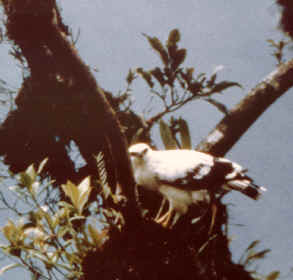
White Hawk
The Central American Smoky-brown Woodpecker has been moved from the Veniliornis genus to
Picoides.
Also in the AOU 2012 Checklist, there is the first NEW bird species to have been found in the United States in nearly four decades, 37 years.
But the bird was identified in a museum collection! It has been seen in life, but not often.
The bird is the Byron's Shearwater, Puffinus
byroni. It was described in 2011, but from a specimen that had been collected in 1963 on Midway Atoll, northwest of Hawaii in the Pacific Ocean.
At that time, that small shearwater was thought to be a Little Shearwater. Later, a second specimen was tagged and recorded on Midway in 1990.
In February of this year, DNA tests on 6 specimens of Puffinus
byroni, found on the Ogasawara Islands of Japan, alive and dead between 1997 and 2011, determined the birds to be
Byron's Shearwaters.
It is assumed that the species still survives in the uninhabited Japanese Ogasawara Islands.
The above narrative, along with some photographs, as well AOU changes in summary for the last 3 years are in the FONT website:
Taxonomy Revisions
Also, most the bird-lists in the FONT website have now been updated to reflect the new changes. Those that have not yet been will be soon.
If you missed, in a previous FONT e-mail bulletin, the narrative of our recent Focus On Nature Tour in Iceland, it is here:
Iceland June 2012 Tour Narrative
And, now, a photo gallery of mostly birds from that June 2012 FONT Iceland Tour:
And, now in our website also, a photo gallery of nature during our March 2012
Costa Rica March 2012, again mostly birds, but also some mammals, butterflies, and reptiles.
Regarding a reptile, here's some news about what has been said to be the rarest snake in the world, the Saint Lucia
Racer, Liophis ornatus. This year about a dozen were found!
Liophis ornatus occurs only on the tiny Maria Islet off the Caribbean island of Saint Lucia.
It was declared extinct back in 1936, with its population having declined on Saint Lucia following the introduction of the predatory
Mongoose, causing its disappearance on the island.
But on the offshore 30-acre, rocky Maria Islet, it was found again in 1973.
And, now, more recently, this year, after it was thought to have gone extinct again, 11 individuals were found there on the islet, bringing it back from the brink again.
The Saint Lucia Racer is a small, brown, non-venomous snake, that can be gentle and docile.
An interesting item such as this are among those in the lists & photo galleries of various wildlife
throughout the FONT website:
I recently, this week, had the good experience of doing a program, at a birding club in Pennsylvania, about
"Birds & Other Nature in Chile", incorporating some poems by the renowned Chilean poet, Pablo Neruda.
You can read here: those poems and others by
Neruda
And I would be pleased to give such a program to other clubs and organizations about
Chile, Brazil, Costa Rica, Iceland, and other fascinating places. Please contact us if interested.
![]()
FONT E-News, Volume 22, Number 4
June 20, 2012
A Recent FONT Tour in Iceland, with Puffins, Ptarmigan, Phalaropes,
Foxes, Whales, and More
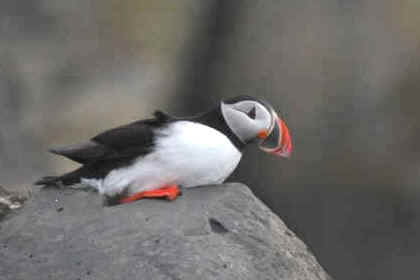
An Atlantic Puffin
photographed during
the FONT Iceland Tour in June 2012
(photo by Gabi Hauser)
During June 2012, we truly had a wonderful
and enjoyable tour in Iceland. We circled
the entire island, counter-clockwise, and then some as we went to the
westernmost point in Iceland, the impressive Latrabjarg
Cliffs where we saw thousands of
nesting seabirds including Fulmars, Kittiwakes, both Common
and Thick-billed Murres, and the favorite of most, the Atlantic
Puffins.
While Iceland itself is of course an island,
the fourth largest island in the Atlantic, and called
Island by the locals, we visited two notable smaller Icelandic
islands during the tour: Flatey in the big
bay known as Breidafjordur, and Heimaey,
one of formerly 14, now 15 islands in the Westmann
Islands group. At both we also enjoyed, again, that favorite of most, the Puffin.
Also during the tour we were at the most powerful waterfall in Europe,
the largest glacier in Europe, and the lake with the most ducks
of any in the world.
We saw volcanoes and more waterfalls, and many birds
in addition to those already mentioned, as well as other wildlife too including 2 Blue
Whales, the Northern Minke Whale, White-beaked Dolphins, 3
Arctic Foxes, both Gray Seal and Harbor Seal, and Reindeer,
as well as an assortment of wildflowers.
All of these natural aspects of Iceland were in addition to some fine
food and Icelandic culture (and wonderful weather).
During our last day, which was the Icelandic Independence Day, prior to
our departing flight, we were in the capital city of
Reykjavik, where the Icelandic people, young, old, and in between,
and with some in old-time garb, paraded down the main street, commemorating their
country's national holiday.
When our tour was finished, we all felt that we had really experienced
Iceland, one of the most beautiful places on Earth, in so many ways.
Above, I have just skimmed the surface as to our FONT Iceland
tour in June 2012, our 18th tour
in that country. A more-complete narrative follows:
During over two
decades, there have been FONT birding and nature tours on varied islands
throughout the world, including those in places as far-flung as the Caribbean,
Japan, and Iceland.
In the Caribbean, we've been to Barbuda
and Barbados, Dominica
and the Dominican Republic, Saint
Lucia and Saint
Vincent, as well as the Caymans, Jamaica,
Puerto Rico, and Guadeloupe.
Off the west coast of the main Japanese island of Honshu,
we've been, over a half-dozen times, on the tiny island of Hegura,
in the Sea of Japan, where in the spring,
bird migration has been extraordinary. And we've seen specialty birds and
butterflies on the small Japanese islands of Amami
and Okinawa.
But different than any other island we've visited has been
Iceland, a place with fire and ice and much in between, and many
birds. As of our June 2012 tour, we've
done 18 tours in Iceland.
Iceland, about the size of the US state of
Kentucky, has with it a number of smaller islands. During our
June 2012 Iceland Tour, we visited
two especially notable, Flatey and Heimaey.
Flatey is one of over 2,000 islands in the
big bay in western Iceland with a big name, Breidafjordur.
Like Hegura in Japan,
Flatey Island is very small, only about a
mile long and less in width, and with only a very few motorized vehicles, almost
none. Cars can not exit the ferry onto Flatey,
as they can not onto Hegura. On Flatey,
we saw two tractors and one small utility truck.
In the small village, there are some wooden buildings painted various colors.
The place is picturesque. Our weather was superb, making our time on the island
and the setting and scenery equally so.
Only 4 people live year-round on Flatey. The
other cottages, along with a small hotel and restaurant, are only in use in the
summer.
Whereas people are few on Flatey, birds
are many.
As we walked along the lane, as noted as stated without a car in sight, there were some Red-necked
Phalaropes walking on the road with us, catching some small little insects
as they went, on the ground and on roadside flowers. Those little phalaropes
were literally at our feet. Others were on nearby pools of water spinning around
as phalaropes do.
On the roof of one of the small houses, a male Snow Bunting sang a
beautiful song. Nesting Snow Buntings are rather common on Flatey.
In the air, above us, Common Snipes were displaying, or winnowing in fast
flight, with the reverberating sound that comes from from their wings. Another
shorebird, or wader, the Common Redshank continuously scolded us as we
walked along our way. Even better at scolding were the Arctic Terns.
"Shrieking" would a more appropriate word for them, and even though
there's no "Common" as an adjective in their name, they were.
Along the mostly-rocky coastline, there were Common Eiders, many of them,
and mostly with their little ones, eiderettes.
Also among the birds along the coast, there were European Shags, that we
watched fly, fish and swim.
As we sat on some coast-side rocks, Black Guillemots in breeding plumage,
with their black bodies, white wing-patches, and red feet, were beside us, or on
the nearby water.
As we sat on a grassy bluff by the sea, Atlantic Puffins, with their
bright red feet, were below us on the water. Others flew out from their burrows
between the seaside rocks. Northern Fulmars flew out from their stony
perches.
Flatey was a wonderful place to be, and
during our entire time there the birds that were always around kept reminding us of their
presence. In all, we saw 18 species of birds on the island. But it wasn't so
much that we saw 18 species. It was that we "experienced" them.
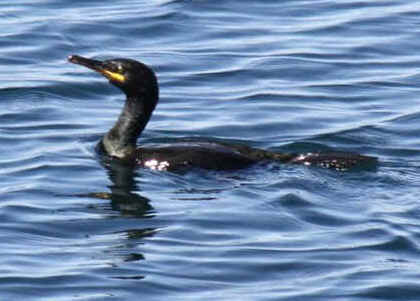
A swimming European Shag photographed during
the FONT Iceland Tour in June 2012
(photo by Gabi Hauser)
Heimaey Island is one of 15 small islands
off the south coast of Iceland known collectively as the Westmann
Islands, or in Icelandic, Vestmannaeyjar.
The islands are said to have been created entirely by volcanic activity, after
the end of the last glaciation and since. Most recently, the 15th of the
islands, named Surtsey, was created during a
submarine eruption between 1963 and 1967.
Heimaey is the largest of the Westmanns,
and the only island of the group inhabited by people. All of the islands are
inhabited by birds, notably seabirds, with many of them nesting on
sheer cliffs.
Under 3 miles in length, Heimaey Island has
had some dramatic volcanic history. In January 1973, an eruption began there,
just beyond and above the one town on the island. The entire population of about
5,000 people was successfully evacuated during one night by boat and plane. The
eruption continued until May. Lava flowed down into the streets. About half of
the town became submerged by it. During our visit in June
2012, we saw remnants of houses now covered
by volcanic soil where flowers, notably Lupin, flourish.
The Westmanns, including
Heimaey Island, are, as just noted, the haunts of many nesting
seabirds.
During the ferry ride to and from, and near the islands, we saw Manx
Shearwaters, Northern Gannets, Great Skuas, Parasitic Jaegers, and gulls,
along with many Arctic Terns, Black-legged Kittiwakes, Northern
Fulmars, and numerous alcids including Common Murres, Razorbills,
and Atlantic Puffins - a plethora of puffins.
Manx Shearwaters breed in Iceland only in the Westmanns,
and the Gannet and the Great Skua are most commonly seen in
Iceland along and off the southern coast.
But it was in far-northwest Iceland where we saw the most seabirds. At the
western end of a rugged peninsula, at the western end of Iceland that is also
the western end of Europe, we visited the Latrabjarg
Cliffs. From there, it is about 300 miles across the sea to the
hyperborean coast of Greenland.
The Latrabjarg Cliffs are massive and truly
one of the most impressive places anywhere in the world, and especially so for
those who like being where birds are.
The cliffs rise to over 1,650 feet above the ocean, and they continue for 12
kilometers, or 7 and a half miles. And they teem with nesting seabirds
including a huge number of alcids, fulmars, and kittiwakes.
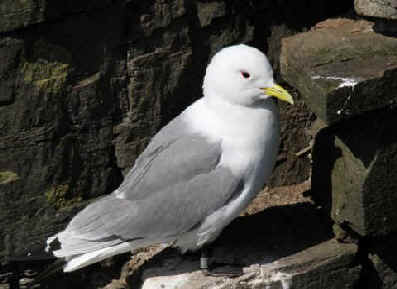
A Black-legged Kittiwake cliffside
during the FONT Iceland Tour in June 2012
(photo by Gabi Hauser)
Among the alcids at Latrabjarg, there
are tens of thousands of Thick-billed Murres (known in Europe as Brunnich's
Guillemots), alongside vast numbers of Common Murres (known in Europe
as Common Guillemots).
About 40 per cent of the Common Murres in the North Atlantic breed in
Iceland with, it has been said, over a million pairs. About 75 per cent
of the Common Murres that breed in Iceland
do so on the 3 largest bird-cliffs of the western fjords of northwestern
Iceland. One of those 3 cliffs is Latrabjarg.
Those same 3 cliffs in northwestern Iceland,
including Latrabjarg, are the nesting sites
of about 90 per cent of the Thick-billed Murres that breed in Iceland,
and that area has the largest number of Thick-billed Murres in the North
Atlantic. It has been said that about 580,000 breeding pairs of Thick-billed
Murres nest in Iceland.
An estimated one-third of the world's Razorbills nest at
Latrabjarg. We saw them nicely on the ledges, either standing erectly
or resting on their bellies.
The Razorbills at Latrabjarg
constitute the largest known colony of the species in the world. About 60 per
cent of Icelandic Razorbills breed there. The population of Razorbills
in Iceland has been said to be an estimated
380,000 breeding pairs.
But it is the Atlantic Puffin that is the star of the show at
Latrabjarg. Late in the day, atop the cliffs, there are just so
photogenic. And so tame, allowing humans to be unimaginably close to them.
I watched people lying on the ground as they photographed the Puffins.
The lying people and standing birds were eye-to-eye.
I couldn't help but observe as I watched the few dozen people who were there,
either lying on the ground or walking on the dirt path, within reach of the Puffins,
that they certainly were smitten by them.
All the people noticed, of course, the impressiveness of the place and the
swarms of seabirds on the cliffs, in the air, and in the water. But it was that
"chorus line" of sorts of continuous Puffins, one after the
other, and so very close, that got the most attention from person after person.
People certainly liked the "Sea Parrots", as Puffins are
also called.
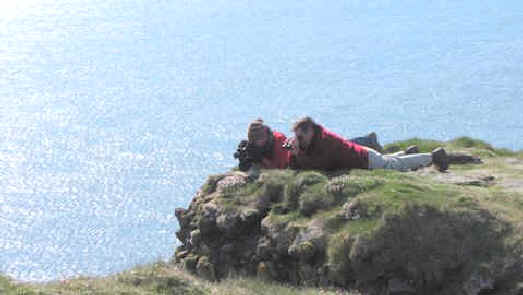
Looking at the seabirds
on the clifftop,
1,650 feet above the ocean,
during the FONT Iceland Tour in June 2012
(photo by Gabi Hauser)
Following here are some other birds with which we had notable experiences during our June
2012 Iceland Tour:
About half of the Great Skuas in the world breed in Iceland,
with an estimated 5,000 pairs. Most nest on barren ground along the southeastern
coast.
One of the Great Skuas, that we saw in that region of Iceland, was very
close to us in a pool alongside the road. Seemingly it was holding down some
prey in the water. The big, dark bird with the splashing is what first caught
our attention. After that went on for a while, however, the Skua lifted
up into the sky but with nothing in its talons.
Late the previous evening, we had watched two dark-morph Parasitic Jaegers
(or Arctic Skuas) methodically creating havoc among Arctic Terns,
and some gulls and shorebirds (or waders), as they, the jaegers
that is, continuously and quickly flew around above the other birds nesting on
the grassy ground. But in the end, at least as long as we were there, those
Parasitic Jaegers came up empty-taloned as well.
Nearby, another predator was in the air and then on the ground, a Short-eared
Owl.
Red-throated Loons (or Red-throated Divers) in their breeding
plumage as they floated on a pool of still water, were, with whatever name,
memorable.
Actually, they were beautiful with their burgundy-red throats, light-gray heads,
and the lines on the back of their necks. But when that species vocalized, it lacked
the beauty of the sound of the Common Loon (or Great Northern
Diver) that we also saw.
The Common Loon nests in Europe only in Iceland, and two other birds also
have that same distinction, the attractive Barrow's Goldeneye, and the
more than attractive Harlequin Duck. The colorful male Harlequin
is downright gaudy.
But the most fascinating aspect of the Harlequin Ducks that we watched
was how they swan so well underwater in a very swift river. Both males and
females did so together in pairs. But the female appeared to stay underwater
longer in the fast current.
The Barrow's Goldeneye and Harlequin Duck were just two of the
species of waterbirds that we saw in the area of Lake
Myvatn in northern Iceland. That lake is said to have the most
nesting ducks of any lake in the world.
One of the most colorful of the waterbirds that we saw there was the Horned
(or Slavonian) Grebe in its bright breeding attire. How many birds are
there with bright yellow-orange head plumes?
Lacking much color were the Glaucous Gulls and Iceland Gulls that
we saw saw along the coast in northern Iceland. They were all-white, with one
species, the Iceland, a smaller version of
the other.
The Glaucous Gull is quite common in that area.
The Iceland Gull was not, as we were there in June. The Iceland Gull is
more common in Iceland in the fall, winter,
and spring. Actually, the Iceland Gull does not nest in Iceland.
It does so further north, in Greenland. A
few, mostly non-adults, linger in Iceland in
the summer.
In the highlands of north-central Iceland, we enjoyed the Pink-footed Geese.
Generally they were timid birds, keeping their distance, but we saw a nice
number of them well. We saw flocks of Pink-footed Geese, and a few, at
various places, with their young.
A book that I like is entitled "In Search of the Pink-Headed Duck",
referring to a duck now thought to be extinct that was in India. In the book, the searchers
found much, but not the non-existent duck.
However, the Pink-footed Goose can be found, as we did find it, in the
wild highlands, where no people live, in Iceland.
Also in that area, at some ponds, we found breeding-plumaged Purple Sandpiper,
and also in their breeding attire, Long-tailed Ducks.
The Purple Sandpiper does not nest along the coast, and where and when
the species does, it is the male that rears the young, with the same role also
had by male Red-necked Phalaropes that were also with nesting territories
in the same area where we found the Purple Sandpiper.
Female Red-necked
Phalaropes have more color and a bolder pattern in their breeding plumage
than the males.
The Long-tailed Duck has just been classified by Birdlife International
as a "vulnerable species", as globally its population has been
declining. That is unfortunate, as it is such a beautiful bird, both the male
and the female, and both in and out of breeding plumage.
Another bird that is as "non-existent" now as the Pink-Headed Duck
is the Great Auk. It did live, formerly, in
Iceland, and in fact the last known Great Auks lived there.
From the top of a cliff along the south coast of Iceland, we could see the
offshore island where the last Great Auks died in 1844. Where we were on
that cliff-top, there is now a large sculpture of the bird.
Returning to the Pink-footed Goose, and a positive thread: The total Pink-footed
Goose population of Iceland and
Greenland combined, in the autumn, has grown ten-fold during recent
decades, from about 23,000 birds in 1952 to 230,000 birds in 1995. Most of those
birds winter in Scotland and northern England. They depart from Iceland
in October.
I've noted that during our June 2012 tour in
Iceland that we saw the goslings of Pink-footed
Geese and the ducklings of Common Eiders.
Among other birds that we saw as youngsters with adults were those of Greylag
Geese, Eurasian Oystercatcher, White Wagtail, and Snow
Bunting, in addition to cygnets with Whooper Swans.
In addition to the displaying of many Common Snipe, high in the sky,
there were flight displays, again and again, both in the video and audio mode of
European Golden Plover, Common Redshank, and Whimbrel.
Among passerine songsters during the tour, there were two Turdus
thrushes, the Redwing and the Blackbird.
The former is common throughout Iceland. The
latter is a recent addition to the spring and summer Icelandic avifauna. It is
localized.
Outside, one day, where we were having a lunch inside, there was, on the other
side of the window, a nice grouping of Redpolls, also feeding on food
provided for them.
The resident endemic subspecies of the Common Redpoll in Iceland is Acanthis
flammea islandica, sometimes referred to as the "Icelandic
Redpoll".
Another day, after our dinner, in a field behind the restaurant, there were Ptarmigan.
First, a male Rock Ptarmigan was nicely in clear view on a rock,
posing in the light of the late-day sun. Then the female appeared, equally as
nice to view in that late-day sunlight. Not far from the nest, she also posed
for a while, before slipping back to it in the grass. What a great experience
that was - seeing the Ptarmigans as we did, with both Snipe and Whimbrel
displaying around us, by a high hillside next to a pristine seacoast in
northern Iceland - after having yet another good, Icelandic meal.
The Rock Ptarmigan in Iceland in the
summer is an endemic subspecies, Lagopus mutus islandorum. In all,
globally, there are 27 subspecies of Rock Ptarmigan, with most on islands
or in other remote places.
Yes, there were birds during our June 2012
Iceland Tour - many of them. But, as probably it has been conveyed here,
there were not just birds.
We also saw the cliffs, volcanoes, waterfalls, glacial lakes, icebergs
from a calving glacier, hot springs, boiling mud pools, steam vents
and other geological phenomena, and innumerable wildflowers.
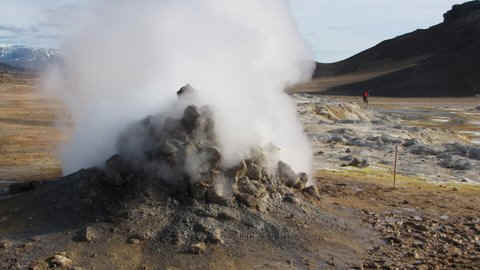
An Icelandic hot spring
In conclusion, some comments now about mammals we observed that included
both Harbor and Grey Seals, Arctic Foxes, Reindeer,
White-beaked Dolphins, Northern Minke Whales, and Blue Whales:
We saw 3 Arctic Foxes. One was all-dark, the "Blue Fox",
and two had white, or "off-white" tails. Later in the year, some Arctic
Foxes in Iceland are all-white, as we've seen during our tours there in October.
We saw Reindeer, as we traveled, in 3 groups. The animal, with its
scientific name Rangifer tarandus, is called Reindeer in Europe
and the Caribou in North America.
It was first introduced into Iceland in
1771, with 13 individuals from northern Norway. There were no further
introductions.
Numbers increased and peaked in the mid-19th Century. The population then
declined rapidly, until less than 200 were left in 1940.
Now, only in eastern Iceland, numbers have
increased again, and are stabilized at about 3,000.
Off the north coast
of Iceland, with a scenic backdrop of snow-topped mountains and
coastline, we had the very good fortune of seeing two magnificent creatures, two
Blue Whales.
The Blue Whale is the largest of all living creatures on Earth. And it is
the largest ever known to have existed.
It can be with a length of 100 feet and the weight of up to 150 tons. We saw
well portions of the bluish-gray backs of both animals, their fins, and the huge
flukes of their tails before they dove. We were able to stay with them for 3 of
their dives, each of which lasted about 10 minutes.
So big and so rare is the Blue Whale. It is estimated that only about
1,500 exist in the North Atlantic Ocean, with also about that same number in the
North Pacific Ocean. The Antarctic population is said to be only about 6,000
individuals.
The Blue Whale in the northern oceans is one of 3 subspecies, Balaenoptera
musculus musculus. It is believed that the populations, or subspecies, in
the Northern & Southern Hemispheres never meet.
We were so lucky that our path, as we did a counter-clockwise "circle
tour" around Iceland, and the path of
the Blue Whales did meet.
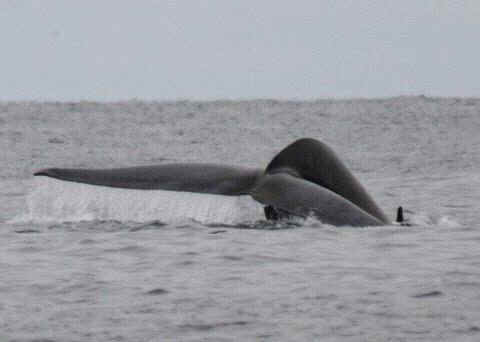
A Blue Whale photographed
during the June 2012 FONT tour in Iceland,
1 of the 2 Blue Whales that were seen
The Blue Whale is classified as
a globally endangered species. Following
the slaughter of 30,000 of them in the Antarctic season of 1930-31, the
population never really recovered. But at least, now into the 21st Century, it
is not extinct.
When the big Blue Whale was given its scientific name by Linnaeus in
1758, it sometimes is thought of as 18th Century humor, as the Latin "musculus"
means "little mouse". But that word can also mean "muscle"
and that would be appropriate for the largest animal the world has ever known, that
constantly swims and dives deeply in the ocean.
Also during that same sea-trip off northern Iceland,
we saw at least one Northern Minke Whale and a couple pods of White-beaked
Dolphins, along with a Pomarine Jaeger (unusual for Iceland) and
numerous Arctic Terns, Northern Fulmars, some Common Murres, and
again Puffins, with many of them, in groups, sitting on the surface of
the sea and then sometimes flying and more often diving.
Yes, we were fortunate to see the Blue Whales, but also fortunate to see
and experience so much else during our June 2012
Iceland Tour, that was the 56th FONT tour in Europe
and the 18th in Iceland.

A
traditional Icelandic lunch
in the northwestern fjords region
during a FONT Iceland Tour
![]()
FONT E-News, Volume 22, Number 3
June
6, 2012
Snowy Plover, Kirtland's
Warbler & Wolves in
Wisconsin
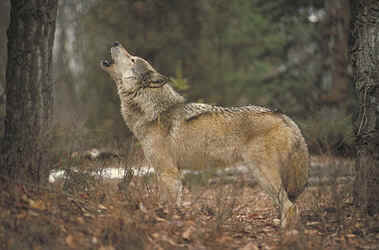
A howling wolf
![]()
FONT E-News, Volume 22, Number 2
March 31, 2012
Recent FONT Tours in Costa Rica & the Dominican Republic
Recent FONT birding & nature tours have been in two places
good for
both birds and other nature, Costa Rica
&
the Dominican Republic.
Costa Rica is well known for its varied Neotropical birding, and
the Dominican Republic is also good for birds, including about
30 species
endemic to the Caribbean island of Hispaniola.
Our recent Costa Rica & Dominican Republic tours were enjoyable
& with lots of birds and
other nature seen.
In March 2012, there were two back-to-back
FONT tours in Costa Rica, one in the
northern part of the country, and one in the southern.
Places that were visited were in the highlands and lowlands, up on
volcanoes
and down by the seacoast, and including the dry "cattle country"
near Nicaragua and moist "rain forest" near Panama.
And these were
just some of the habitats where we were. There were others in between the
dry and wet, and the high and low.
Our March 2012 Costa Rica tours were our
31st and 32nd in that country.
During the northern and southern Costa Rica tours combined, as many as 372
species of birds were found. All but just a few were seen. There were
some that were only heard. All were alive, except for one: a Chiriqui
Quail-Dove, that had recently died, by a dirt road on the Caribbean
slope.
Among the 371 living species of birds during the tour, there were a number
of notables, including: Jabiru, King Vulture, Aplomado Falcon,
Pearl Kite, Swallow-tailed Kite, White Hawk, Black Hawk-Eagle, Sungrebe,
Southern Lapwing, Long-billed Curlew, Scarlet Macaw, Green Thorntail (both
male & female), the Snowcap, Resplendent Quetzal, Baird's Trogon
(both male & female seen nicely), Long-tailed Manakin, Turquoise
Cotinga, Three-wattled Bellbird, both Fork-tailed and Scissor-tailed
Flycatchers, Streak-chested Antpitta, both Long-tailed and
Black-and-Yellow Silky-Flycatchers, Tropical Mockingbird (a
recent arrival in Costa Rica), and the Black-cheeked Ant-Tanager
(a very localized endemic in Costa Rica - 1 of 3 endemic Costa Rican birds
that we saw - there are only 4).
Where tinamous are heard, one knows that the tropical forest is still
good, as it has been for a long time with its assortment of wildlife. We
were glad to hear Tinamous, mostly Great and Little, at
a few places during the tour.
Tinamous are more often heard than seen, considerably more often, but
we did have wonderful sightings of a Thicket Tinamou walking on a forest floor, and of two Little Tinamous (one a moment or so
after another) crossing a country road just ahead of us.
Wonderful to hear, at one of the places where we stayed in the mountains,
were the late-day and early-morning sounds of nightingale-thrushes,
many of them with their plaintive calls, near our nice cabins. We saw them
as well: the Ruddy-capped and Orange-billed Nightingale-Thrushes.
The Black-billed Nightingale-Thrush was "further up the
road".
It was noted here (3 paragraphs ago) that the Tropical Mockingbird is
a "recent arrival" in Costa Rica. Also in that category, during
our tour, were: the Pearl Kite (also noted above), and the Mouse-colored
Tyrannulet and both the Red-breasted and Melodious Blackbirds.
In all, there were so many birds. We saw more Double-striped Thick-knees
than usual. We had a wonderful look at Mangrove Cuckoo, and our
second Black-billed Cuckoo ever (in 32 CR tours).
We enjoyed hearing and seeing a Common Potoo at dusk (only our 3rd
time in 32 tours).
The Toucans, as always, were enjoyed, both the Keel-billed and
the Chestnut-mandibled, as were the Tanagers, as colorful as
ever. Most colorful among them were the Golden-hooded, Silver-throated,
Bay-headed, and Flame-colored, along with the frequently-seen Cherrie's
Tanager. The old name of the Cherrie's, the Scarlet-rumped
Tanager, related more to its bright coloration.
Brightly-colored Euphonias that we saw included the Yellow-crowned,
Yellow-throated, Spot-crowned, Tawny-capped, Thick-billed, and Scrub
- all of them colorful.
Other brightly-colored birds included 3 species of Honeycreepers (Shining,
Green, and Red-legged) and 2 species of Dacnis (Blue
and Scarlet-thighed).
And of course, not to be omitted in the "colorful category" are
the hummingbirds. During our March 2012 Costa Rica tours, we saw 32
species of hummingbirds.
But birds of all sorts were enjoyed, including the finches, seedeaters,
and sparrows.
Finches included the Peg-billed and the Large-footed
(also known to us as "Bigfoot").
Seedeaters included the White-collared, Variable, Yellow-bellied,
and Ruddy-breasted.
Sparrows included the Stripe-headed, Black-striped, and Orange-billed
(the last of these especially fine to see).
The Volcano Junco, a resident on only the highest mountains, was a
special treat for us.
And lastly, as brightly-colored as any of the birds categorized above as
"colorful" was the male Painted Bunting that was
seen during a boat-ride, late one afternoon, in mangroves.
The nearby male Mangrove Warbler was not bad to see either, with its
yellow body and rusty head in the late-day sunshine.
As already said, there were "so many birds". At the end of the
tours, we all had to "narrow it down" to only ten, our Top
Ten favorites.
Here, collectively, are those favorite birds of the FONT
tours in March 2012 in Costa Rica:
1 - Resplendent Quetzal
2 - Snowcap
3 - Three-wattled Bellbird
4 - Silver-throated Tanager
5 - Long-tailed Manakin
6 - Bay-headed Tanager
7 - Golden-hooded Tanager
8 - Long-tailed Silky-Flycatcher
9 - White Hawk
10 - Gartered (formerly Violaceous) Trogon
11 - Baird's Trogon
12 - Streak-chested Antpitta
13 - Little Tinamou
14 - Sungrebe
15 - Blue-crowned Motmot
16 - Volcano Junco
17 - Olivaceous Piculet
18 - Tropical Mockingbird
19 - Pearl Kite
20 - Green Thorntail
21 - Aplomado Falcon
22 - Green Violetear
Not just birds were seen during our March 2012
Costa Rica tours.
Among the mammals, there were 3 species of monkeys, with the
often-encountered Mantled Howler Monkeys, White-faced Capuchins,
and the least common of the monkeys in Costa Rica, the attractive Squirrel
Monkey. Also: Coatis and Agoutis.
Among the reptiles, there were Crocodile and Caiman,
Iguanas and Basilisk.
Among the many and diverse butterflies, there were the Blue
Morphos, that could not ever be ignored, along with an assortment of
Longwings, Leafwings and Daggerwings, and Sulphurs, Sisters,
Crackers, and Peacocks.
In all, it was a wonderful two tours in a country that's great for nature,
with birds and otherwise, and during which we also enjoyed some wonderful
places and fine times, along with some good wit, good humor, and good eyes.
Click the following link to read more about our March 2012 tours in Costa
Rica:
More about the FONT Costa Rica Tour in March 2012
*******
Among the birds
during the 18th FONT tour in the Dominican
Republic, in February 2012,
was one that we've never encountered previously, the Eastern Chat-Tanager,
a skulker and a rarity, and one of the least observed of Hispaniolan endemic
birds.
Actually, the bird is 1 of only 3 of the over 30 Hispaniolan endemic birds
that is endemic to the Dominican Republic,
not occurring in Haiti, the other country on the island of Hispaniola.
The other 2 Dominican Republic endemics are the rare Ridgway's Hawk
and the Bay-breasted Cuckoo.
The Eastern Chat-Tanager was seen during our February
2012 tour as we spent some more time than usual in the high
mountains in the middle of the country known as the Cordillera Central.
We birded there mostly at an altitude of about 7,500 to 8,000 feet above sea
level. The highest peak in the entire Caribbean is in that area, at 10,319
feet above sea level.
Another avian denizen that we encountered there was another bird
that does not lend itself to much observation, the secretive Bicknell's
Thrush. Nearly the entire population of that species winters on the
island of Hispaniola, in mountainous forests composed of pines and other
highland plants.
Also in that area is the only populations of the Rufous-collared Sparrow
outside Central and South
America, as well as a very isolated resident population of the Pine
Warbler, a species otherwise in North America and in the nearby Bahamas.
In the Dominican Republic, on Hispaniola,
in the central mountains and elsewhere, there are a number of interesting
birds, including endemic species and subspecies, with rarities among them,
that we enjoyed during our tour, along with some other nature also endemic
and rare.
Click the following link for photos from our February 2012 tour in the
Dominican Republic:
A
Photo Gallery of Dominican Republic Nature, Scenery, & Culture during the February 2012 FONT Tour
![]()
FONT E-News, Volume 22, Number 1
January 5, 2012
The Recent FONT Tour in Chile: With
Parakeets, Penguins, and the Pudu
Our recent birding and nature tour in November 2011 in Chile
was enjoyable indeed! It was spring there, in that beautifully scenic
and diverse country.
We went from the Andes Mountains to the Pacific
Ocean. From Santiago, in central Chile, we went south to
Chiloe Island, a wonderful place to be.
Among the birds during the tour: Andean Condor, Burrowing
Parakeet, Slender-billed Parakeet, Humboldt Penguin, Magellanic Penguin,
Gray-breasted Seedsnipe, Many-colored Rush Tyrant, Crag Chilia,
Snowy-crowned Tern, Great Grebe, Kelp Goose, Flightless Steamer Duck, and
Black-necked Swans with cygnets riding on their backs.
Also: 3 species of oystercatchers, and 4 species of cormorants including the
beautiful Red-legged Cormorant.
And these are just some of the birds. There were many more.
Among the mammals during the tour: a Kodkod (a wild cat), a
Pudu (the smallest deer in the world), a Grison,
an Akodont (a vole-like mammal), and the Marine
Otter (a relative of the Sea Otter of the Northern Hemisphere).
![]()
FONT E-News,
Volume 21, Number 15
October 4, 2011
A Quiz with Two
Questions (A Sentence with Two Qs)
"What Species are they?"
Number 1:
In 1784, in England, a
man named Thomas Pennant published "Arctic Zoology".
In it, there was a beautifully detailed engraving of two birds. One was a
Pied-billed Grebe, shown as it should be, on the water.
But the other bird in the illustration was problematic.
It was standing on the bank of a shore, with its webbed feet firmly on the
ground.
It was in strange company being with the grebe, but even more strange
(or wrong) was its being on a dirt bank.
Also incorrect in the engraving was the thrust of its head, the splay
of its legs, and the angle of its body.
But so few Europeans, if any, who looked at the beautiful engraving, had
ever seen the bird. So the image did not seem implausible.
The species had yet to be described. It would be, 5 years later, in 1789.
But its nest would not be found until nearly 200
years later, in 1974. That was even though ornithologists looked
diligently for it for decades.
That nest was found to be high in coniferous trees, miles away from the
sea where the bird usually seen, and no where "the dirt bank of
a shore" where the bird never is.
That first nest was found in the most populous state in the United States.
WHAT IS THE SPECIES?
Number 2:
This bird has evolved a complex, communal social system, of
"cooperative breeding".
The colony, of this species, is an extended family (kinship) group that
consists of a breeding core of 4 or more males, usually brothers or a
father and his sons, who share up to 3 related females, usually sisters or
a mother and her daughters.
Older offspring may join in the group as "helpers", attending to
the granaries and assisting in raising younger birds.
The word "granaries" is a clue.
Such granaries are found in the most populous state in the United
States.
WHAT IS THE SPECIES?
The above & more can be found in the FONT website: www.focusonnature.com
![]()
FONT E-News, Volume 21, Number 14
September 19, 2011
![]()
FONT E-NEWS, Volume 21, Number 13
August 10, 2011
Jaguar & Jabirus in Brazil
In Brazil, FONT conducted its 50th
birding and nature tour in that country since 1991.
In Mato Grosso do Sul, in a region known as the
Pantanal - a region known for its wonderful wildlife, there were large
concentrations of birds, along with mammals and other nature.
Previously, we had seen Jaguar during 4 Brazilian tours in Mato Grosso do
Sul, once previously during the day, and 3 times previously at night.
On August 10, 2011, at about 10 o'clock in the morning, we had another daytime Jaguar sighting. By
a channel of water. it was at a concrete covert, for just a short time, before
disappearing into the covert and probably out the other side.
Where we saw the Jaguar, we travel about in the area on high, open vehicles. The previous night, in
such a vehicle, we enjoyed a great look at an Ocelot, after seeing 3 Giant
Anteaters, Crab-eating Foxes, Marsh Deer, 6-banded or
Yellow Armadillos, Capybaras, and Caiman. We saw 3 species of
nightjars, and heard another.
Among the numerous birds, during this tour in Brazil, were Jabirus (the largest American stork), the Hyacinth Macaw
(the largest
parrot in the world), the Greater Rhea (the largest American
bird), and the
Toco Toucan (the largest toucan). In all, nearly 200 species of birds.
Wishing you the best,
Armas Hill
![]()
![]()
FONT E-NEWS, Volume 21, Number 11
July 27, 2011
Again
a Gallinule as it should be, and more
In July 2011, in the latest supplement of the AOU (the American
Ornithologists Union), it became the Common Gallinule throughout the Americas,
Gallinula galeata, now a distinct species from the Common Moorhen, Gallinula
chloropus, of the Old World.
After all, it is GALLINULA galeata !
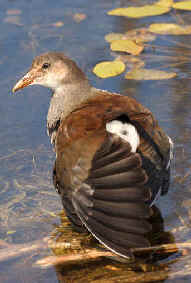
Common Gallinule
The only other member of Gallinula in the New World is Gallinula melanops, the
Spot-flanked Gallinule in South America.
And the Snowy Plover of the Americas, Charadrius nivosus, is distinct from the
Kentish Plover, Charadrius alexandrinus, of the Old World.
The Mexican Jay in the US has a new scientific name, Aphelocoma
wollweberi, as a portion of its population in Mexico has been split to be a
new species, the Transvolcanic Jay, Aphelocoma ultramarina.
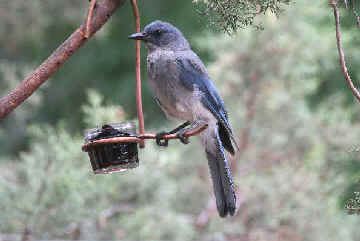
A Mexican Jay during a FONT
tour
Further to the south, if you've seen the Chestnut-mandibled Toucan in Costa
Rica, you may be interested that it is now part of the more-southerly Black-mandibled
Toucan, Ramphastos ambiguus.
If in the West Indies or northern South America, you've seen what has
been called the American Bare-eyed Thrush, it now has a new name, the
Spectacled Thrush. It is still Turdus nudigenis.
Among the Wood Warblers, throughout the Americas, there has been a major
taxonomic revision. In North America, no species have been "lost",
and none have been "gained", but there have been some notable
changes as to the genera.
"Parula" is still in the common English names for the Northern and
Tropical Parulas, but that genus is now gone.
What has been a large genus, Dendroica, is now gone.
The birds that have been in it, as well as the two Parulas, are now in the
genus where, until now, there has only been one bird, the American
Redstart.
That now large genus is Setophaga.
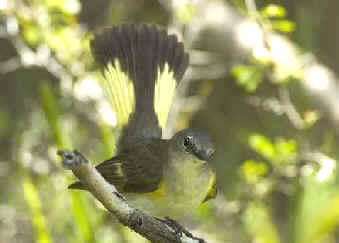
A female American Redstart
The genus Wilsonia no longer exists. From it, the Hooded Warbler is now in Setophaga,
while the Canada Warbler and the Wilson's Warbler are now in Cardellina, where
previously there was only the Red-faced Warbler that only reaches the US in
Arizona.
Also now in the expanded Cardellina genus is the Red Warbler in Mexico, and if
you've never seen the dainty Pink-headed Warbler in Guatemala, you might like
to know that it is now in Cardellina as well. The Red and the
Pink-headed Warblers were in the now defunct genus, Ergaticus.
The Connecticut Warbler is now the only member of the Oporornis genus. The
similar Mourning and MacGillivray's Warblers, along with the Kentucky
Warbler,
have now gone to Geothlypis, the genus of the Yellowthroats.
If you've seen the Barbuda Warbler or the Saint Lucia Warbler on those
respective Caribbean islands, or the Adelaide's or Elfin Wood Warblers in
Puerto Rico, the Arrowhead Warbler in Jamaica, the Vitelline Warbler in the
Cayman Islands, or the Plumbeous Warbler on Dominica or Guadeloupe, you may
wish to know that they are all now in the genus Setophaga, rather than Dendroica.
In Mexico and Guatemala, the Fan-tailed Warbler, formerly the sole member of
Euthlypis, is now in the genus Basileuterus, along with, among others, the
warbler that has the largest range of any in the Americas, the Golden-crowned
Warbler, that has also now been called the Stripe-crowned Warbler.
In the Bahamas, there is now a new species. The Bahama Warbler, Setophaga
flavescens, is now distinct from the Yellow-throated Warbler, formerly
Dendroica, now Setophaga dominica.
According to the July 2011 AOU List, the Yellow-breasted Chat is still a
"problematic" warbler, and the Mountain Chickadee remains as it has
been, one species.
What you've read here, is now in the FONT website: www.focusonnature.com
![]()
FONT E-NEWS, Volume 21, Number 10
July 22, 2011
Lists
& a Quiz, Tours, & Frogs
In the Focus On
Nature Tours (FONT) website: www.focusonnature.com
there are numerous lists, some with photos, of: birds,
mammals, butterflies, amphibians & reptiles, marine life, plant life,
other wildlife. Just scroll down the left-side of the home-page to the links.
Lists of birds include those, among others, in North
America (in 6 parts), Arizona, California, Colorado, North Carolina, Texas,
and in Mexico, and the Caribbean (in 2 parts), Hispaniola, Jamaica, Lesser
Antilles, Puerto Rico, in Central America (in 4 parts), Belize, Costa Rica,
Guatemala, Panama, in South America in Argentina, Brazil (in 3 parts), Chile,
in Europe (in 2 parts), Iceland, Spain, Sweden, and in Japan (in 2 parts).
Now, here's the quiz:
In one of the bird-lists just noted, in which there are over 375
species, there are these birds:
Red-breasted Goose
Mandarin Duck
Bufflehead
Black-browed Albatross
Sooty Tern
Yellow-bellied Sapsucker
American Robin
Siberian Rubythroat
Cerulean Warbler
Rustic Bunting
What is the country?
If you send us an e-mail, correctly naming the country, you'll be entitled to
a 10 per cent discount on a future tour to that country.
I must note that during our nearly 20 tours in that country, we've never seen
any of these species, but they are on that country's "list" of birds
that have been documented as occurring there.
As mentioned above, there are other lists of nature in the FONT website. One
that has just been done is a complete list of amphibians and reptiles in
Brazil.
In that list, over 1,525 species. But what's quite fascinating is that if that
list had been done just 30 years or so ago, it would have had one
two-thirds as many species.
Since the 1970s, just over 500 species of amphibians and
reptiles in Brazil have been described as new to science.
Since the year 2000, nearly 200 species have been described
there. Many of them have been frogs, but there have been
lizards and snakes also.
Many have been actual discoveries, rather than taxonomic "splits" of
previously-known species.
When I was typing the list, I almost felt as if new frogs and the like were
being found as I typed! It made it, for me, an enjoyable project.
And all the more fascinating as throughout the world, it is often being noted
that frogs and their kind are either declining or disappearing. Species that
were once known to exist, or were even once common, have been searched for
unsuccessfully.
Regarding Brazil, it is, granted, a big, very big country. And in many places
in the country, there has been little natural exploration.
A number of the newly-discovered amphibians have limited ranges, in isolated
forest and hills.
What would be interesting would be to pursue further and find out how many of
the "new" species are rare.
Interesting also, would be to find out, but unfortunately we probably never
will, how many species that existed in recent decades were never discovered.
In the Brazil Amphibian & Reptile List, there are about 800 species of
amphibians and 500 of reptiles. of those, over half of the amphibians (456)
are endemic to Brazil. And about half (246) of the reptiles are endemic.
Also in the FONT website, a List of Mammals of Brazil has
also just been completed, with just over 600 in the country. Of them, 175
are endemic.
And there have been some discoveries of "new species" in recent
years, including, among the larger animals, a new peccary, a new deer, and a
few new monkeys. In all, about 100 species of monkeys and allies are now known
to live in Brazil.
40 per cent of the Brazilian mammals classified as threatened are
primates.
With the 600 mammal species noted, Brazil has the most of any country in the
world. 66 of the Brazilian mammal species are classified as endangered.
As to birds, there are about 1,720 species in
Brazil (that's why the bird-list in our website is in 3 parts).
Approaching 1,100 species of birds have been found during FONT tours in
Brazil.
190 of the Brazilian bird species are endemic, and more than that are
considered threatened.
My doing a Brazilian Amphibian & Reptile List came about, partly, as
some people traveling with me in Brazil have commented that I should encompass
more relating to Brazilian nature (there's so much! ), in addition to the
birds that have, over the years, been my main emphasis.
And so I will be adding other website files and printed material also for
categories such as Brazilian orchids and Brazilian
fruits.
The second of these categories, by the way, have been especially enjoyed
during our Brazilian tours at meals - especially the wonderful fresh
fruits on the table at breakfasts!
About 825 different types of fruits are grown in Brazil, and over 300
different kinds are from plants native to the country.
As noted, Brazil is a big country. And, as there have been 49 FONT tours in
Brazil, during the last 2 decades, we've been to a number of very interesting
places. Having said that however, we've never seen anyone, at any of those
places, either observing or studying frogs. But there must be such people,
somewhere, somehow, across the country, because as I've noted here, so many
new species of particularly amphibians have recently been discovered.
Our next FONT tour in Brazil, is May
4-14, 2012.
Click here for more about: Upcoming FONT tours in Brazil
A tour scheduled for the fall, to be
about a week in Wisconsin and Minnesota,
October 13-21, 2012,
including visits to the International Crane Foundation and the
renowned "Birds in Art" exhibit at the Leigh Yawkley Museum in
Wisconsin, and the Hawk Ridge Bird Observatory in Minnesota, where the raptors
should be flowing by during their southward migration.
In September 2012, there's still some availability on our tour in Washington
State & California, September
7-16.
Our hearts have gone out this year to people who live where we've toured in
the past, in Arizona and in Japan.
In Arizona, there has been disruption, and sadly destruction, at some of the
places we've enjoyed visiting.
Regarding Japan, we just received a message forwarded to us by someone in
Australia who traveled with us 3 times in Japan over the years. That message,
from a nature center where we've been near Tokyo, relates how things have been
there as of late. For example, this summer, due to the problem of there being
less operative power plants in the country, there has been a strongly
restricted use of energy.
In 2013, we'll go to Japan again,
January 25-February 6, for
the various cranes, eagles, and Blakiston's Fish Owl, on the northern island
of Hokkaido and the southern island of Kyushu.
Nest year, we're scheduled to go to Arizona, again,
August 26-September 7.
The other day, while going through some files, I came across a
little blue notebook filled with Japanese writing on the left pages and
corresponding English writing on the right.
An elderly man from California, who was on one of our Japan
tours in the 1990s, and who had previously worked for the U.S. State
Department in China, took the time to translate for me, some text from a
Japanese book about, of all things, gulls. He did that
translation, and I remember that he enjoyed doing it, during spare time,
mostly in the evenings, during the tour.
So, now, I'm pleased to have found that little note book, with Graham's little
writing, describing the various plumages and cycles of the likes of the Vega
Gull and others of that ilk in Japan.
It brings to my mind another occurrence at the end of a FONT tour in
Iceland a few years back, when one of the people on the tour,
from New Jersey, asked me to take him into Reykyavik, before we went to the
airport, to the Hofdi House where President Reagan and the Soviet Secretary
General Gorbachev had met in 1986.
When we got there, that same man who had taken a number of nice bird photos
during the tour, walked about photographing the house. His wife told me at
that time that he had been there previously when Reagan and Gorbachev were, as
he had been at that time the US ambassador to the Soviet Union. She told
me that he wanted to go back and see the place again, one more time.
Such people, from tours in Japan and Iceland, are among the many fine people
that I've had the good experience of meeting during FONT tours over the
years.
Earlier here, I referred to lists of birds, mammals, and other nature.
But the most important list I have here is that of 2,103 people
who have participated, during the last 2 decades, on FONT tours and
pelagic trips.
1,684 of those people participated more than once. That's about 80 per cent.
And about half of them participated more than twice, with a nice number doing
so as many as a half dozen times or more.
Wishing you the best,
Armas Hill